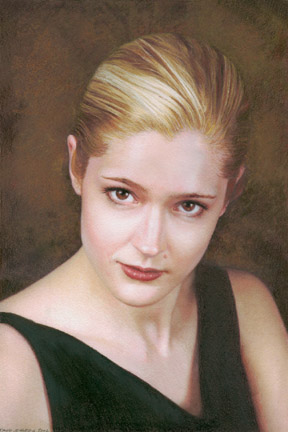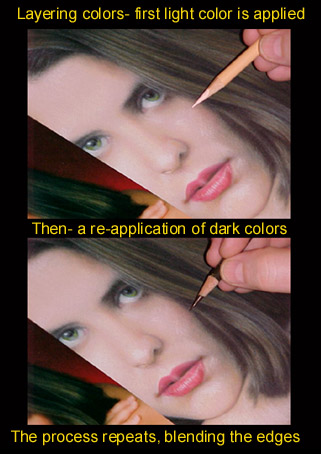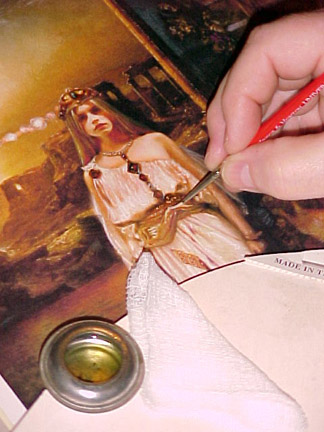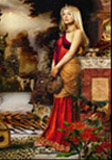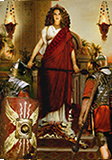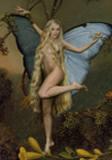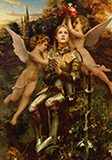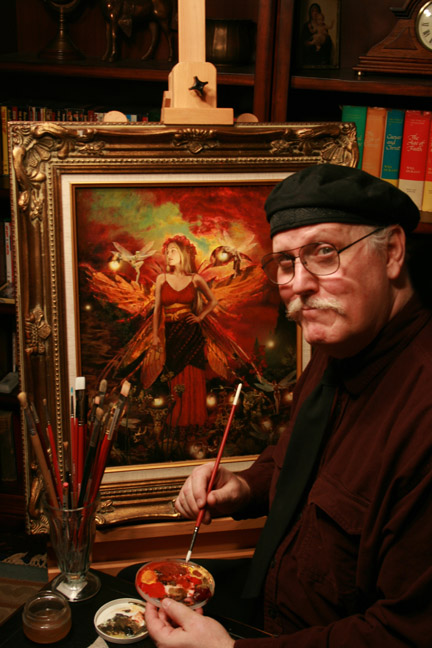 |

Portrait Art in Colored Pencil & Various Mixed Media Realistic Portrait Art Technique: A free preview of Art Lessons in Drawing, Painting, Portraiture, Photography in both Analog & Digital Media. From the Secrets of the Old Masters to the Secrets of the New Masters. Newly Updated! Welcome! Content wider than your screen? Turn your mobile device sideways to fit ~ We tried the device-width app and it scrambles the contents on half the phones... ( go figure) |
|
|
Original Artwork on Paper by Howard David Johnson
|
||
|
Admission Free Portrait Art Gallery & Tutorial
"Since the times of the ancient Greeks, Art History records a relentless quest for Realism and artistic excellence in realistic paintings and sculpture. The masters of each generation strove to perfect their craft, then passed on the torch of their accumulated knowledge and skill to the next generation. The accomplishments and technological breakthroughs of one generation have often set new standards of excellence for the next." ~ H.D.J.
|


"There is no greater compliment to a photo-realist than disbelief." ~HDJ
 |
 |
 |
| Pencil drawing | Original Analog studio photography | Close-up |
Young girl from India -001 1996: Here's a half-finished drawing, to begin with... DELIBERATELY left unfinished. Media: burnt umber, sepia, and yellow ochre colored pencils on smooth bristol board... Of course all of these Portraits shown here employ his original photography. These simple headshot portrait drawings, based on photos he has taken in his studio usually only take him about a day to create. Complex illustrations such as "Pandora's Box" shown below and those seen in his other Art exhibits take longer. This kind of photo shoot is VERY hard work. The hardest and most time consuming part is finding the right girls and scheduling studio time for the portrait photography session with their busy schedules and shooting the source photos - After more than 30 years of practice, the drawings from these photos are relaxing, fun, and easy by comparison.



Young girl from India -002 1996; media: Ebony pencil smudged with blending stumps on very rough textured bristol board. These portraits helped refine his techniques for his illustrations. Many of his story telling illustrations in colored pencils, acrylics and Oils are for sale, but these portraits are very personal work and are shown only to help aspiring portrait artists and are usually not for sale at any price. Keep scrolling down to see comparisons between his photographs, colored pencil & oil paintings as well as more large Colored Pencil Art, a free art lesson & information about more free lessons & Foundations for Art: his paid private lessons.


Ann -1 2002; media: burnt umber with sepia, and yellow ochre Prismacolors with Ebony pencil lowlights on Strathmore #400 Bristol Board. ( Note the individual hairs shaved in with razor knife and highlights touched up with white Prismacolor. ) The background is applied so thick it used up four umber colored pencils.


Grace -1 2000; media: Plain old number two pencils, ebony pencils, and a variety of erasers. Early on I used my thumb and forefinger with great force to smooth out unruly areas and then would add more pencil and smudge again. Later after several applications I polished it with tissue. Rolling a rounded grey kneaded eraser over it smoothed roughly blended areas too. This got the grays smooth but I had lost my lightest and darkest values in the process. I then erased out the lightest areas with a #2 pencil eraser. Lastly I added sharp pencil details with an Ebony pencil and darkened the darkest darks to restore the 5 shades of the value scale.



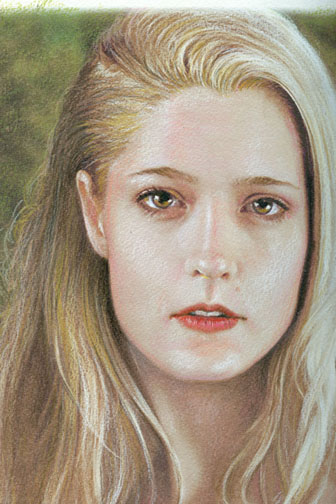
Jessica - (Colored Pencil Portrait #0004) and a close-up to the right rendered in Prismacolors with Ebony pencil lowlights on Windsor & Newton Cotman 140 lb. Water Color Paper . Even with nothing but pencil and paper the use of original photography as a source makes this mixed media. See Johnson's Photographic artistry page for his newly updated exhibit of photographic portraits, some used here.
Did you know the old masters often traced?
Leonardo Da Vinci used "Camera Obscura" which is a lens and a mirror set at an angle with parchment over it to trace onto. Michelangelo used a similar technique. Great Realistic Painters began employing photography as a mechanical aid immediately after it's invention in the 1800's. This is not surprising since artists had been tracing from Camera Obscura for thousands of years. Famous Myths; Leonardo Da Vinci (1452- 1519 ) is often credited with the invention of Camera Obscura because he used it for his masterworks during the Renaissance and mentioned it in his notebooks, but this is simply not true. Similarly, Americans are credited with the camera, but it is also not true. The earliest description of Camera Obscura occurs in the great optical treatise Opticae Thesaurus ( Book of optics ) of the Islamic scientist Al-Hazen who died at Cairo, Egypt in A.D. 1098. Since he says he did not invent it, we know it came sooner.
STYLE and TECHNIQUE
Blair - 1996 (below right) was rendered in Prismacolor Colored Pencils from the photograph taken by the artist. " I wear magnifying glasses while I work like a jeweler. If I can satisfy myself that my colored pencil portraits look good under magnification, the illusion will usually fool the naked eye. One correction computers can't really do well at all is recover from a photo like this one that's just too dark. I was able to easily fix that in the drawing though."~ HDJ

Analog Photograph

Colored Pencil Drawing
Of course Johnson starts with an outline just like everybody else...after his studio photography portrait session... He usually shoots a whole roll of nearly identical shots per portrait idea in 35 mm format to get one to work from when doing his colored pencil portrait art. To get it absolutely perfect he enlarges it on a Xerox machine and traces it on a glass lap board like a light table. The kind of pencils you use make all the difference. Think that tracing makes it too quick and easy? You'll find once you've finally got that outline done right you're a long, long, way from being finished in any medium...
Raw umber and Sepia Prismacolors are always better than a graphite outline as they blend better with the later colors.


The next and hardest stage in HDJ's photo realistic colored pencil technique is to rough in the shapes and shades of light and shadow with crosshatch or other drawing patterns working from photographs taken in his studio as a guide. Here is a rough and simplistic example to give you the idea. Black and white # 2 and Ebony pencil or Colored Pencils, the technique is almost the same. Raw umber and Sepia Prismacolors are always better than a graphite outline for color as they blend better with the later colors. My portraits employ a much sharper pencil and a more refined approach, but I'm sure you get the idea. After the crosshatch is built up, for flesh tones especially, the pencils are polished down with tissue paper, then kneaded erasers- almost rubbed away- until the paper is stained with color but there is no waxy buildup remaining. This is the perfect underlayment surface to begin laying crosshatch on...
Next a sharper, more precise layer of crosshatch is applied...and polished with tissue and index finger or thumb for trouble spots. Repeat the polishing, erasing, and redrawing process several times... The dark and light areas like on the side of the face blend as the layers build-up. A heavy waxy color build-up is permissible on the background and her lips, eyes and hair, but not the skin. This kind of dry underlayment also works well with soft pastels. This color buildup stage is why some artist's colored pencil drawings resemble oil paintings and photographs and others look sketchy. And of course Practice, Practice, Practice, and did I mention Practice?
Below Left: Original 35MM Photo of model Ann Bratton. Right: Original Colored Pencil Drawing.



...With the portrait above right, a selection of different colored pencils are used with intermixing. Sepias, umbers, for the layout then the reds, salmons, peaches, and lots of burnishing layers and top layers with whites were used, with a touch of green for the eyes. Ann's portrait shown here was done on #400 Strathmore double ply bristol board. Of course the large original art has a glow no photo could ever have that you can't see here on the web.
Then another layer is added, and another and another. The picture shown above has more than fifty thin transparent layers. Warning: Keep additional layers thin - most pencils will crack if you try to apply the additional layers too thick in the large LIGHT areas like the forehead and cheeks. Tips: Tissue paper (Toilet tissue) is the miracle ingredient for photo-realism - intense pressure in circular motions, followed by a new layer of fine crosshatch. He sometimes uses his erasers to draw with during this stage as much as his pencils.
 |
 |
Then there's even more varieties of mixed media... You can mix other media with your colored pencils like Soft Pastels -left- and Acrylics -right- for mad amounts of fun... There is no one way to do it right... but you can find the way that's right for you, or for your next picture- don't be afraid to experiment! Practice, Practice, Practice, Oh, and did I mention Practice? This next picture below "Miss Lillian" was done five years before David ever sat at a computer station - it employed yellow ochre, sepia, black and white colored pencils on # 400 Strathmore Bristol Board and employed no burnishing, smudging, or polishing techniques, simply fine point pencils, applied super-fine point crosshatch heightened with white and and then shaved away for sharper highlights with a #2 exacto-knife... Since 1996 David does not do these kind of pictures for money anymore, he draws portraits in Prismacolor now to relax, for fun, for love and for the families of his subjects to treasure!
"You sure can't get textures & effects like these with computers! Believe me- I've tried! There is NO such filter!" ~ HDJ
|
Here's what you need to get started: It's not very expensive! An electric pencil sharpener, A dozen # 2 pencils with good virgin erasers, a Dozen Ebony pencils, (or facsimile ) A set of 48 or more colored pencils, preferably Original Prismacolors or a facsimile. Bristol board or smooth drawing paper, a kneaded ( stretchy ) eraser, magic rub erasers, art gum erasers, toilet paper, & lots of blending stumps, small, medium, & large. - but most of all - have fun! |


There are those who believe artists who use mechanical aids can't draw free hand and demand artists all prove their talent first by drawing WITHOUT any mechanical aids. Hilarious. These pencil drawings below and HUNDREDS of others he did in the 1970's WITHOUT tracing settled this issue forever when he was a teenager.


I was against mechanical aids myself in those days, but when I found out that ALL the artists I admired most used all the mechanical aids at their disposal, and I had not been told this, I started using them myself.

"Jesus walking on the Sea" Graphite 1978 was done without any mechanical aids of any kind or reference whatsoever. Those of you who feel the need to judge my talent, just compare it with Michelangelo's work done at the same age. I think talent is overrated and hard work is a hundred times more important than talent when it comes to creating good art. I've known a lot of talented people who were so lazy that hard workers with next to no talent and a teachable spirit easily surpassed them. There is no substitute for hard work, not even mechanical aids...
|
"Elven Fairy Magic" |
"Napoleon at Waterloo" |
|
Art & Technology: New Art Media for the 21st Century! Colored Pencil Paintings? Now with my story telling illustrations as shown below - like Helen of Troy, The Oracle, and Pandora's Box -You BET I use Computers! And just for fun I have several free web pages posted explaining the role of mechanical aids in the creation of these pictures! Here's my question: Why are artists pressured to stay with 16th century methods and not doctors? Where does this come from? Why aren't doctors pressured to avoid progress so they can continue to bleed us and put leeches on us? The answer is obvious. The double standard applied to visual artists seems crazy to me.
|
||||||||||


